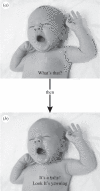Neither infants nor toddlers catch yawns from their mothers
- PMID: 21123252
- PMCID: PMC3097853
- DOI: 10.1098/rsbl.2010.0966
Neither infants nor toddlers catch yawns from their mothers
Abstract
This study aimed to clarify whether infants and preschool children show susceptibility to contagious yawning, a well-known effect that has been demonstrated experimentally in older children and adults by exposing them to video sequences showing yawns. In a first study, parents kept a log of their child's yawns for a one week period. None of the log entries reported any contagious yawns by the children. Although less frequent than in older children and adults, spontaneous yawning by infants and preschoolers showed the typical morning, post-wakening peak, and an increase before bedtime in the evening. In an experimental study, infants and preschoolers watched a presentation that included many images of yawning and a repeated video clip of their own mother yawning, but there was no evidence of contagious yawning. The results suggest that, even when witnessing yawns by someone with whom they have a strong and positive emotional relationship, very young children do not show contagious yawning.
Figures


Similar articles
-
Do dogs (Canis familiaris) show contagious yawning?Anim Cogn. 2009 Nov;12(6):833-7. doi: 10.1007/s10071-009-0233-0. Epub 2009 May 19. Anim Cogn. 2009. PMID: 19452178
-
Contagious yawning in chimpanzees.Proc Biol Sci. 2004 Dec 7;271 Suppl 6(Suppl 6):S468-70. doi: 10.1098/rsbl.2004.0224. Proc Biol Sci. 2004. PMID: 15801606 Free PMC article.
-
Non-human primates: a comparative developmental perspective on yawning.Front Neurol Neurosci. 2010;28:63-76. doi: 10.1159/000307082. Epub 2010 Mar 26. Front Neurol Neurosci. 2010. PMID: 20357464 Review.
-
Earlier than previously thought: Yawn contagion in preschool children.Dev Psychobiol. 2021 Jul;63(5):931-944. doi: 10.1002/dev.22094. Epub 2021 Jan 27. Dev Psychobiol. 2021. PMID: 33506489
-
Why do we yawn? The importance of evidence for specific yawn-induced effects.Neurosci Biobehav Rev. 2011 Apr;35(5):1302-4. doi: 10.1016/j.neubiorev.2010.12.004. Epub 2010 Dec 17. Neurosci Biobehav Rev. 2011. PMID: 21168437 Review.
Cited by
-
The thermoregulatory theory of yawning: what we know from over 5 years of research.Front Neurosci. 2013 Jan 2;6:188. doi: 10.3389/fnins.2012.00188. eCollection 2012. Front Neurosci. 2013. PMID: 23293583 Free PMC article.
-
Yawn contagion in domestic pigs (Sus scrofa).Sci Rep. 2021 Jan 20;11(1):1851. doi: 10.1038/s41598-020-80545-1. Sci Rep. 2021. PMID: 33473157 Free PMC article.
-
Presence of contagious yawning in children with autism spectrum disorder.Autism Res Treat. 2013;2013:971686. doi: 10.1155/2013/971686. Epub 2013 Jul 22. Autism Res Treat. 2013. PMID: 23970970 Free PMC article.
-
Development of fetal yawn compared with non-yawn mouth openings from 24-36 weeks gestation.PLoS One. 2012;7(11):e50569. doi: 10.1371/journal.pone.0050569. Epub 2012 Nov 21. PLoS One. 2012. PMID: 23185638 Free PMC article.
-
Yawn contagion in humans and bonobos: emotional affinity matters more than species.PeerJ. 2014 Aug 12;2:e519. doi: 10.7717/peerj.519. eCollection 2014. PeerJ. 2014. PMID: 25165630 Free PMC article.
References
-
- Walusinski O. 2006. Yawning: unsuspected avenue for a better undertanding of arousal and interoception. Med. Hypotheses 67, 6–1410.1016/j.mehy.2006.01.020 (doi:10.1016/j.mehy.2006.01.020) - DOI - DOI - PubMed
-
- Sepulveda W., Mangiamarchi M. 1995. Fetal yawning. Ultrasound Obstet. Gynecol. 5, 57–5910.1046/j.1469-0705.1995.05010057.x (doi:10.1046/j.1469-0705.1995.05010057.x) - DOI - DOI - PubMed
-
- Giganti F., Hayes M. J., Cioni G., Salzarulo P. 2007. Yawning frequency and distribution in preterm and near term infants assessed throughout 24-h recordings. Infant Behav. Dev. 30, 641–64710.1016/j.infbeh.2007.03.005 (doi:10.1016/j.infbeh.2007.03.005) - DOI - DOI - PubMed
-
- Koch P., Montagner H., Soussignan R. 1987. Variation of behavioral and physiological variables in children attending kindergarten and primary school. Chronobiol. Int. 4, 525–53510.3109/07420528709078544 (doi:10.3109/07420528709078544) - DOI - DOI - PubMed
-
- Giganti F., Esposito Ziello M. 2009. Contagious and spontaneous yawning in autistic and typically developing children. Curr. Psychol. Lett. 25 (http://cpl.revues.org/index4810.html)
MeSH terms
LinkOut - more resources
Full Text Sources
Medical

